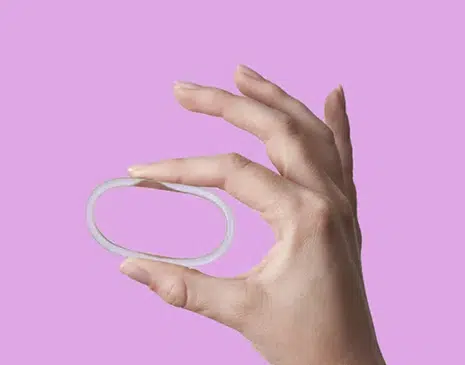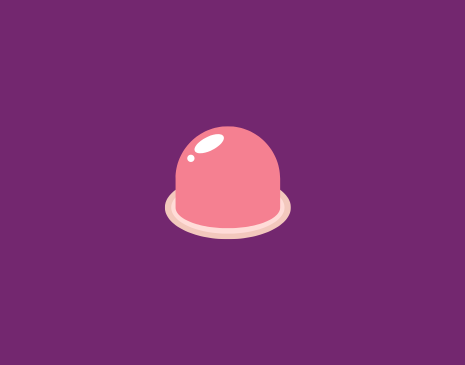A vaginal ring is a soft latex-free plastic ring that contains two hormones, oestrogen and progestogen.
When inserted correctly into the vagina, the ring slowly releases these hormones into the blood circulation. Because of the low amount of hormones that is released, it’s is considered a low-dose hormonal contraceptive. Since a vaginal ring releases two different types of hormones it is a so-called combined hormonal contraceptive. These are like the hormones that are produced by the ovaries and used in the ‘The Pill’ (combined pill).
The vaginal ring works just like a combined contraceptive pill (the Pill) but instead of taking a pill every day, the ring is used for 3 weeks in a row. Which is handy for those who forget to take their pill each day.
How does it work?
The vaginal ring works by stopping the ovaries from releasing an egg each month.
If used correctly the ring is at least 99% effective at preventing pregnancy. If you forget to put a new ring in, use it incorrectly or take certain medications, it might only be 93% effective. Remember though, it does not protect from STI’s .
It also thickens the fluid around the cervix (opening to the uterus/womb). This helps to prevent the sperm from entering.
When you start the vaginal ring for the first time or after a break it can take up to seven days to start working.
Three weeks in, one week out
- Starting with the day you put it in, the vaginal ring must be left in place without interruption for 3 weeks.
- After 3 weeks you remove the ring on the same day of the week and at approximately the same time as it was put in. For example, if you put it in on a Wednesday at about 22.00 h, you should remove the ring 3 weeks later, on Wednesday, at about 22.00 h.
- After you have removed the ring, you do not use a ring for 1 week. During this week a vaginal bleed should occur. Usually this starts 2-3 days after removal of the ring.
- Start a new ring exactly after the 1 week interval (again on the same day of the week and approximately the same time), even if you have not stopped bleeding. If the new ring is inserted more than 3 hours too late, the protection from pregnancy may be reduced.
What is good about the vaginal ring?
- It can be used to skip your period
- Periods usually become lighter, more regular, and less painful
- Acne can improve
- Chance of getting cancer of the uterus (womb) and ovaries decrease
- It can help with symptoms of polycystic ovary syndrome (PCOS) and endometriosis
- Once stopped your fertility quickly returns to normal
Possible side effects for a small number of users can include:
- An increase in vaginal discharge (fluid from the vagina)
- Irregular vaginal bleeding
- Nausea
- Sore/ tender breasts
- Headaches
- Bloating
- Changes to your skin
- Mood changes
These side effects often settle with time. The ring has not been shown to cause weight gain.
What about sex and periods?!
A small number of women find the ring uncomfortable during sex, but partners are usually not bothered by the ring during sex.
You can use a tampon while using a vaginal ring. But don’t use a diaphragm as a backup method of birth control while using a vaginal ring because the ring can interfere with the placement of the diaphragm.
What to do if…
Your ring is accidentally expelled from the vagina
Your vaginal ring may accidentally be expelled from the vagina for example, if it has not been inserted properly, while removing a tampon, during sexual intercourse, during constipation, or if you have a prolapse of the womb. Therefore, it is a good habit to regularly check whether the ring is still in your vagina (for example, before and after intercourse).
Your ring breaks
Very rarely a vaginal ring may break. A broken ring is unlikely to cause an overdose because the ring will not release a higher amount of contraceptive hormones. Vaginal injury associated with ring breakage has been reported.
If it does break, expulsion of the ring is likely to occur. Therefore, if you notice that your vaginal ring has broken, discard that ring and replace it with a new ring as soon as possible.
You have forgotten to insert a new ring after the ring-free interval
If your ring-free interval was longer than 7 days, put a new ring in as soon as you remember. Use extra contraceptive precautions (such as a male condom) if you have sexual intercourse during the next 7 days. If you had sexual intercourse in the ring-free interval, there is a possibility you may be pregnant. In that case, contact your doctor immediately. The longer the ring-free interval, the higher the risk that you have become pregnant.
You have forgotten to remove the ring
If your ring has been left in place for between 3 and 4 weeks, it will still protect you from pregnancy. Have your regular ring-free interval of one week and subsequently insert a new ring.
If your ring has been left in place for more than 4 weeks there is a possibility of becoming pregnant. Contact your doctor before you start with a new ring.
You want to change the first day of your menstrual period
If you follow the instructions for the vaginal ring, your menstrual period (withdrawal bleed) will begin in the ring-free interval. If you want to change the day it starts, you can make the ring-free interval shorter (but never longer!). For example, if your ring-free interval begins on a Friday, you can change this to a Tuesday (3 days earlier). Simply insert your next ring 3 days earlier than usual.
If you make your ring-free interval very short (e.g. 3 days or less), you may not have your usual bleeding. You may have spotting (drops or flecks of blood) or breakthrough bleeding while using the next ring.
You want to delay your menstrual period
Delay of your menstrual period (withdrawal bleed) is possible by inserting a new ring immediately after removing the current ring, with no ring-free interval between rings. You can leave the new ring inserted for up to a maximum of 3 weeks. You may experience spotting (drops or flecks of blood) or breakthrough bleeding while using this new ring. When you want your period to begin, just remove the ring. Have your regular ring-free interval of one week and subsequently insert a new ring.
If you’re interested, you can order the vaginal ring through us. Get started now!













